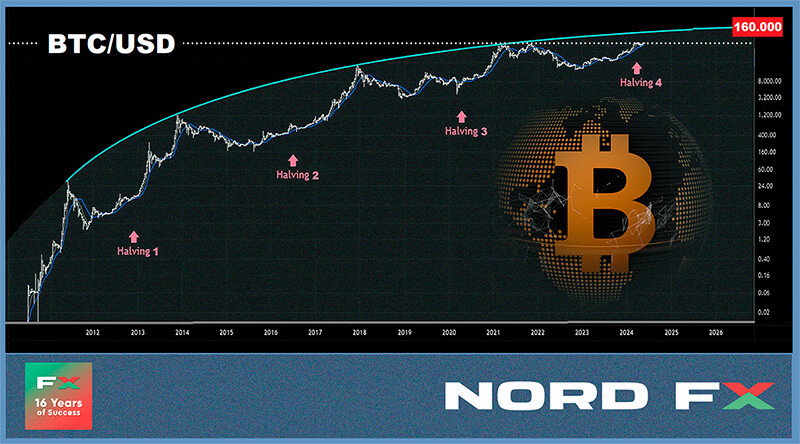- Dec 6, 2017
- 177
- 0
Forex and Cryptocurrency Forecast for 13 – 17 May 2024
EUR/USD: Medium-Term Outlook Favours the Dollar
Throughout the past week, EUR/USD exhibited mixed dynamics, primarily driven by expectations concerning potential interest rate cuts by the US Federal Reserve (Fed) and the European Central Bank (ECB). Statements by officials from both central banks, as well as economic macro-statistics, either heightened or lowered these expectations.
The EUR/USD bullish rally commenced on 16 April from the 1.0600 mark, reaching a peak of 1.0811 on 3 May, after which growth stalled, starting the past week at 1.0762. On Monday, 6 May, statistics from the Eurozone provided some support to the common European currency. In April, the Services Purchasing Managers' Index (PMI) rose from 52.9 to 53.3, exceeding the forecast of 52.9. The Composite PMI, which includes the manufacturing sector and services, increased from 51.4 to 51.7. Germany's Composite PMI also showed positive dynamics, rising from 50.5 to 50.6. Consequently, business activity in the Eurozone reached its highest level in almost a year. Moreover, retail sales in the region showed significant growth, rising from -0.5% to +0.7% year-on-year.
This news backdrop suggests potential inflation growth, which in theory could deter the ECB from initiating a monetary policy easing. However, ECB Chief Economist Philip Lane stated that the Executive Board of the bank has compelling arguments for a rate cut at the 6 June meeting. Another ECB representative, Lithuanian Central Bank head Gediminas Simkus, indicated that rate cuts should not be limited to June, suggesting it could happen thrice by the end of the year. However, while the likelihood of easing (QE) in June is near 100%, there is some uncertainty regarding further steps. ECB Vice President Luis de Guindos admitted that the regulator is cautiously forecasting any trends beyond June.
In addition to ECB officials' statements supporting easing, statistics released on Tuesday, 7 May, also contributed. They showed that manufacturing orders in Germany, the locomotive of the European economy, decreased by 0.4% in March after a 0.8% decline in February. As a result, the EUR/USD pair's growth halted, pulling back to 1.0723.
The pair made another attempt to break through the strong resistance zone of 1.0790-1.0800 on Thursday, 9 May, when US initial jobless claims data was unexpectedly reported at 231K, much worse than the expected 210K. This coincided with a widespread negative session for US yields along the curve. The situation worsened as the unemployment data confirmed concerning statistics released on 3 May. According to the US Bureau of Labor Statistics (BLS), non-farm payrolls (NFP) rose by just 175K in April, significantly below the March figure of 315K and market expectations of 238K. The employment report also showed an increase in unemployment from 3.8% to 3.9%.
Besides combating inflation, the Fed's other declared main goal is maximum employment. "If inflation remains stable and the labor market strong, it would be appropriate to delay rate cuts," stated Fed Chair Jerome Powell. Now, the strength of the labour market is in question. However, the Fed is likely to focus on fighting inflation, which is still far from the 2.0% target.
A key inflation indicator tracked by the Fed, the Personal Consumption Expenditures (PCE) Price Index, rose from 2.5% to 2.7% in March. However, the ISM Manufacturing PMI fell below the key 50.0 mark, dropping from 50.3 to 49.2 points. Remember, a level of 50.0 separates economic growth from contraction. In such a situation, raising the interest rate is inadvisable, but lowering it is also not an option. This is exactly what the FOMC (Federal Open Market Committee) of the Fed did. At its meeting on Wednesday, 1 May, its members unanimously left the rate unchanged at 5.50%. This is the highest rate in 23 years, and the US central bank has kept it unchanged for six consecutive meetings.
The main scenario foresees the Fed beginning to review the rate towards a decrease no earlier than autumn, likely in September, with another cut by year-end. However, if US inflation does not decline or, worse, continues to rise, the regulator may abandon monetary policy easing until early 2025. Thus, considering the above, many analysts believe the medium-term advantage remains with the dollar, and EUR/USD is still attractive for sales with a horizon of several months.
The final point of the week for EUR/USD was at 1.0770, making the weekly result almost zero. Regarding the forecast for the near term, as of the evening of 10 May, it is maximally neutral: 50% expect dollar strengthening, and 50% expect its weakening. Trend indicators on D1 are equally divided: half are on the side of the reds, and half are on the side of the greens. Among oscillators, only 10% voted for the reds, another 10% remained neutral, and 80% voted for the greens (although a quarter of them are already signalling overbought conditions). The nearest support for the pair is located in the 1.0710-1.0725 zone, followed by 1.0650, 1.0600-1.0620, 1.0560, 1.0495-1.0515, 1.0450, 1.0375, 1.0255, 1.0130, and 1.0000. Resistance zones are in the regions of 1.0795-1.0810, 1.0865, 1.0895-1.0925, 1.0965-1.0980, 1.1015, 1.1050, and 1.1100-1.1140.
In the coming week, on Tuesday, 14 May, consumer inflation data (CPI) in Germany and the Producer Price Index (PPI) in the US will be released. Also scheduled for this day is a speech by Fed Chair Jerome Powell. The next day, Wednesday, 15 May, important indicators such as Consumer Price Index (CPI) and retail sales volumes in the United States will be published. On Thursday, 16 May, the traditional number of initial jobless claims in the US will be announced. And at the very end of the working week, on Friday, 17 May, we will learn the Eurozone CPI as a whole, which may influence the ECB's decision regarding the euro interest rate.
GBP/USD: Pound Remains Under Pressure but Holds On
At its meeting on Thursday, 9 May, the Bank of England’s (BoE) Monetary Policy Committee maintained the interest rate at 5.25%, the highest in 16 years. Economists polled by Reuters mostly expected borrowing costs to remain unchanged, with a committee vote ratio of 8 to 1. However, the vote was 7 to 2. During discussions, two committee members supported a rate cut to 5.0%, which market participants interpreted as a step towards the beginning of a policy easing cycle.
At the post-meeting press conference, BoE Governor Andrew Bailey expressed optimism, stating that the UK economy is moving in the right direction. Bailey also noted that “a rate cut next month is quite possible,” but he intends to wait for data on inflation, activity, and the labour market before making a decision. Chief Economist Huw Pill, although he joined the majority in voting to keep the rate unchanged, also expressed growing confidence that the time for a reduction is approaching. He added that “focusing only on the next Bank of England meeting [20 June] is somewhat unreasonable” and that “medium-term inflation forecasts do not necessarily signal rate movements at the next or subsequent meetings.”
Overall, the movement of the GBP/USD pair last week resembled that of the EUR/USD pair. The chart shows a distinct surge on Thursday, 9 May, triggered by data indicating a cooling US labour market. The pound was also supported by optimistic GDP data for the UK for Q1 2024 and manufacturing sector data for March.
GDP (quarter-on-quarter) rose by +0.6% after a decline of -0.3% in the previous quarter (forecast +0.4%). Additionally, the GDP grew by +0.2% year-on-year, recovering from a fall of -0.2%.
As with the euro, the pound is under pressure from the prospect of earlier monetary policy easing by the BoE compared to the Fed. However, the British currency ended the past week above the key 1.2500 level, at 1.2523. Moreover, 65% of analysts expect the pair not only to hold above this horizon but also to continue its growth. The remaining 35% voted for the pair's movement south. As for technical analysis, trend indicators on D1 are split 50-50. Among oscillators, only 10% recommend selling, 40% took a neutral position, and 50% recommend buying (10% of them signal overbought conditions). If the pair rises, it will encounter resistance at levels 1.2575-1.2610, 1.2695-1.2710, 1.2755-1.2775, 1.2800-1.2820, and 1.2885-1.2900. In case of a fall, it will face support levels and zones at 1.2490-1.2500, 1.2450, 1.2400-1.2410, 1.2300-1.2330, 1.2185-1.2210, and 1.2070-1.2110, 1.2035.
The upcoming week's calendar highlights Tuesday, 14 May, when data from the UK labour market will be released. Also of interest is the Inflation Report hearing scheduled for Wednesday, 15 May.
continued below...












